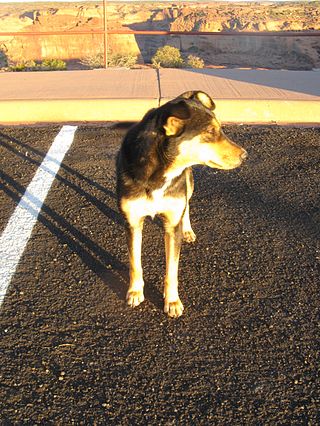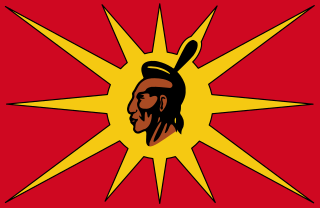
The Indian removal was the United States government policy of ethnic cleansing through forced displacement of self-governing tribes of American Indians from their ancestral homelands in the eastern United States to lands west of the Mississippi River—specifically, to a designated Indian Territory, which many scholars have labeled a genocide. The Indian Removal Act of 1830, the key law which authorized the removal of Native tribes, was signed into law by United States president Andrew Jackson on May 28, 1830. Although Jackson took a hard line on Indian removal, the law was enforced primarily during the Martin Van Buren administration. After the enactment of the Act, approximately 60,000 members of the Cherokee, Muscogee (Creek), Seminole, Chickasaw, and Choctaw nations were forcibly removed from their ancestral homelands, with thousands dying during the Trail of Tears.

Among the Haudenosaunee the Great Law of Peace, also known as Gayanashagowa, is the oral constitution of the Iroquois Confederacy. The law was written on wampum belts, conceived by Dekanawidah, known as the Great Peacemaker, and his spokesman Hiawatha. The original five member nations ratified this constitution near modern-day Victor, New York, with the sixth nation being added in 1722.

The Onondaga people are one of the five original nations of the Haudenosaunee (Iroquois) Confederacy in the Northeastern Woodlands. Their historical homelands are in and around present-day Onondaga County, New York, south of Lake Ontario.

The Ponca people are a nation primarily located in the Great Plains of North America that share a common Ponca culture, history, and language, identified with two Indigenous nations: the Ponca Tribe of Indians of Oklahoma or the Ponca Tribe of Nebraska.
There are four treaties of Buffalo Creek, named for the Buffalo River in New York. The Second Treaty of Buffalo Creek, also known as the Treaty with the New York Indians, 1838, was signed on January 15, 1838 between the Seneca Nation, Mohawk nation, Cayuga nation, Oneida Indian Nation, Onondaga (tribe), Tuscarora (tribe) and the United States. It covered land sales of tribal reservations under the U.S. Indian Removal program, by which they planned to move most eastern tribes to Kansas Territory west of the Mississippi River.

John Napoleon Brinton Hewitt was a linguist and ethnographer who specialized in Iroquoian and other Native American languages. Hewitt was born on the Tuscarora Indian Reservation near Lewiston, New York. His parents were Harriet and David; his mother was of Tuscarora, French, Oneida, and Scottish descent, his father of English and Scottish, but raised in a Tuscarora family. His parents raised him speaking the English language, but when he left the reservation to attend schools in Wilson and Lockport, he learned to speak the Tuscarora language from other students who spoke the language.

Blackfire is a Native American punk rock group. Composed of two brothers and their sister, their musical style is influenced by traditional Navajo Diné music and alternative rock, with political messages about government oppression and human rights. In 2012, members formed the band Sihasin.

Rez dog is usually a term for outdoor, stray, and feral dogs living on Indian reservations in the United States and Indian reserves in Canada. The term has taken on many connotations, and has to some extent become an emblem of and metaphor for reservations/reserves, life on them, and indigenous North Americans in general. For example, a "rez dog" may refer to a resident of indigenous lands.

Tadodaho was a Native American Hoyenah (sachem) of the Onondaga nation before the Deganawidah and Hiawatha formed the Iroquois League. According to oral tradition, he had extraordinary characteristics and was widely feared, but he was persuaded to support the confederacy of the Five Nations.
Canassatego was a leader of the Onondaga nation who became a prominent diplomat and spokesman of the Iroquois Confederacy in the 1740s. He was involved in several controversial land sales to colonial British officials. He is now best known for a speech he gave at the 1744 Treaty of Lancaster, where he recommended that the British colonies emulate the Iroquois by forming a confederacy. He was reportedly assassinated, perhaps by sympathizers or agents of New France.

Erminnie A. Smith, néeErminnie Adelle Platt was a linguist, ethnologist, anthropologist and geologist who worked at the Smithsonian Institution's Bureau of American Ethnology. She has been called the "first woman field ethnographer" and was the first female member elected to the New York Academy of Sciences on November 5, 1877.
Dunquat, known as the Half-King of the Wyandot people, sided with the Kingdom of Great Britain in the American Revolutionary War. He and his people moved to the Ohio country to fight the Americans in the west. He led a mixed band of about 200 Indians at the Siege of Fort Henry (1777). During the war, he protected Christian Delaware people from other members of their tribe prejudiced against their beliefs.
Half King "was particularly attentive to prevent all drunkenness, knowing that bloodshed and murder would immediately follow." He insisted on the removal of the Christian Indians from the vicinity of Sandusky, believing it to be unsafe for them to remain there; he also protected the Moravians and their converts from maltreatment when the missionaries were sent to Detroit ...

The Rotisken’rakéhte, also known as the Mohawk Warrior Society and the Kahnawake Warrior Society, is a Mohawk group that seeks to assert Mohawk authority over their traditional lands, including the use of tactics such as roadblocks, evictions, and occupations.

The Battle of Sorel occurred on June 19, 1610, with Samuel de Champlain supported by the Kingdom of France and his allies, the Huron, Algonquin people, and Montagnais that fought against the Mohawk people in New France at present-day Sorel-Tracy, Quebec. The forces of Champlain armed with the arquebus engaged and killed or captured nearly all of the Mohawks. The battle ended major hostilities with the Mohawks for twenty years.
Donald Andrew Grinde Jr., a professor at the University at Buffalo, is noted for his scholarship and writing on Native American issues.
Franklin Dean LaMere was an American activist and politician. He was a member of the Winnebago Tribe of Nebraska from South Sioux City, and the son of a Gold Star Mother and a combat veteran father. He was a member of the American Indian Movement (AIM) in the 1970s and was noted for his work opposing liquor sales in Whiteclay, Nebraska, a small town whose main industry is selling alcohol to residents of the nearby Pine Ridge Indian Reservation, where alcohol sales are prohibited. LaMere was a leader in the Democratic Party, and served as chairman of the National Native American Caucus. He was a delegate to the Democratic National Convention seven consecutive times from 1988 to 2012.
Marion Gridley was an American historian of Native Americans.
Fish Carrier or "Ojageght," which translates to English as "he is carrying a fish by the forehead strap," was an Iroquois chief of the Cayuga people. He supported the British during the American Revolution, participating in the Battle of Wyoming in 1778 and the Battle of Newtown in 1779.
Leon Shenandoah was an Onondaga politician who headed the Haudenosaunee (Iroquois) Confederacy from 1968 to his death.

Maris Bryant Pierce, was a Seneca Nation chief, lawyer, and teacher. He was a tribal land-rights activist, and a major influence to the Second Treaty of Buffalo Creek of 1838.











